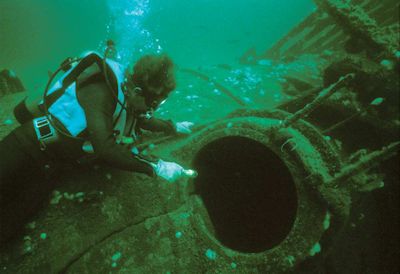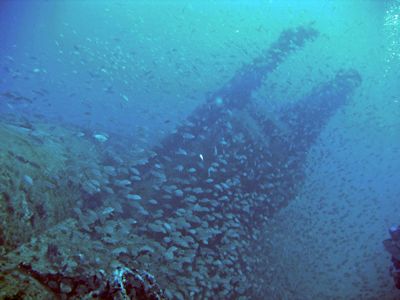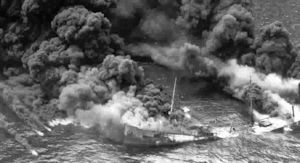 Diver Kevin Bradshaw looks into the forward torpedo-loading hatch of U-85. Photo: Jim Bunch |
 The conning tower of the U-352 is shrouded by fish. Photo: Tortugas Charters. |
HATTERAS — Back in the 1970s, no one thought twice of removing anything off of sunken World War II U-boats, from brass plaques to crew journals to torpedo hatches.
To this day, a treasure trove of historic items salvaged from U-boats sunk off the Outer Banks is safely stashed away in the private homes of divers. And without assurances from the German government and officials with the Graveyard of the Atlantic Museum in Hatteras, hundreds of rare and well-preserved U-boat artifacts will likely remain cloistered from public view.
Supporter Spotlight
“They need the proper place in a museum so that youngsters today know why we’re speaking English,” Phil McGrath, a veteran diver, said in a telephone interview from his home in Daytona Beach, Fla. “But what if you announce what you have, the next thing you know, you have someone knocking at your door?”
Changes in maritime salvage law in 2004, McGrath said, has made divers nervous about possession of the items they’ve gathered over decades, usually at great expense of their own time and money. Often the diver has meticulously researched the history of the vessel and has restored the artifacts.
“A normal wreck diver has no interest in making money,” McGrath said. “They want to preserve history… so that future generations can benefit from what we’ve done.”
Still, U-boat artifacts are rare and sought after. One U-boat collector’s recent Internet advertisement listed numerous items – newspapers, watches, sailor’s uniforms, binoculars, officer’s jackets — starting at $100 euros up to $3,490 euros each.
McGrath, a 60-year-old New Jersey native, said he first came to North Carolina in the mid-1970s to dive on the wreck of the U-85 that sank off Nags Head, about 12 miles east-northeast of Oregon Inlet. A member of the Eastern Diver’s Association, then the only diving group on the East Coast, McGrath said that he was intrigued by the German vessel and the “virgin territory” for divers.
Supporter Spotlight
“That was the beginning of wreck diving,” he recalled. “There were no laws. There were no restrictions of any type. The only thing is you had to honor it as a war grave.”
The U-85, sunk in April 1942, was the first German submarine in World War II attacked on the surface by a U.S Navy warship. After an initial inspection by the Navy, the vessel was ignored for decades except by a few Outer Banks fishermen. Around the time McGrath had heard about the U-85, a couple of entrepreneurial dive boat owners had begun leading dive trips to the vessel, which does not contain any human remains. It soon became one of the most popular wreck dives on the East Coast.
In his book Germany’s U-85: A Shadow In The Sea, published in 2003, Nags Head diver Jim Bunch recounts his first trip to the vessel.
 The tanker Dixie Arrow burns off the N.C. coast on March 26, 1942 after being torpedoed. Photo: National Archives. |
“The wreck was much more intact in the ‘70s than it is today,” Bunch wrote. “…The deck faring was still attached to the pressure hull with many storage compartments evident. Rounds for the 88mm. gun were scattered all over the deck and the two storage containers on top of the pressure hull with torpedoes inside were easy to identify. The periscope and hatch covers were also still in place.”
Since that trip, Bunch has been out to the wreck hundreds of time, making him a veritable U-85 expert. He and his dive buddies Roger and Rich Hunting and Billy Daniels have donated several artifacts from the wreck to the Graveyard of the Atlantic Museum, most notably a rare Enigma machine used by the Germans as a decoder.
In 2002, Bunch wrote, the forward torpedo room, previously filled with sand, was dredged out, revealing for the first time what was stored in the room when the U-boat went down.
“Sea boots, rain-gear, Drager lungs, goggles, life vests and the debris from 12 bunks and three wooden tables were found in the sediment pile,” Bunch wrote. “The remains of 36 lockers that held the enlisted men’s personal belongings still lined the walls on both sides. On the metal floor, dishes, cups, silverware and personal effects were haphazardly scattered about.”
The Enigma machine and other U-85 artifacts were donated to the museum in 2002 officially as gifts from the German government, but Bunch provided no specifics on the whereabouts of the other items, or who salvaged them.
The U-85 today is essentially an empty shell, as is the U-352 off Morehead City, also a favorite recreational wreck dive.
In a recent telephone interview, Bunch said that a post World War II treaty declared that military shipwrecks will always belong to the country of origin, “but over the years the dog-gone things have been salvaged and blown-up and nobody gave a hoot.”
Members of dive trips to the U-85, he said, have included personnel with local police departments, the Coast Guard, the SBI and the FBI.
“Nobody had any concern about breaking any military law or treaty,” Bunch said. “There was really no dialogue about that at all in those days. Absolutely none.”
In 2004, President George H.W. Bush signed the Sunken Military Craft Act, which was intended to clear up ambiguities in maritime salvage law and encourage other nations to have a mutually respectful understanding of sovereign rights. The law clearly states that sunken military aircraft and ships are owned by the nation where they came from, and that any war graves or artifacts they contain are to be protected. It does not forbid recreational diving.
 David Alberg |
 Jim Bunch |
 Joseph Schwarzer |
After the law passed, Bunch said that divers stopped salvaging but continued to enjoy diving on the U-boats. Yet a renegade diver or divers did manage to pillage parts of the U-701, located in deep water off Cape Hatteras. Until then, the location of the vessel, which is believed to entomb 10 sailors, was mostly unknown and the divers were in the process of trying to establish it as a diving preserve. But in late 2004, the radio antenna, a sky periscope, a deck gun and 88 shells were removed from the vessel.
After being notified about the U-701, the German government promised to investigate and possibly take legal action. It is not known if anything was learned about the culprit, although local divers, speaking off the record, said they had a pretty good idea about his identity and motives.
According to Kevin Duffus, author of War Zone: World War II off the North Carolina Coast, the ocean off the Outer Banks was the prime hunting grounds for U-boats, comparing the narrow shipping lane off treacherous Diamond Shoals to “an arcade shooting gallery” for the enemy submarines. By July 1942, Duffus wrote, U-boats had killed 5,000 people and sank 397 vessels off the U.S coast. Of them, 1,700 people and 78 boats were lost off North Carolina.
A U-boat exhibit is one of the highlights planned at the Graveyard of the Atlantic Museum, which is working on an exhibit plan that is expected to be completed in about 18 months. As part of the Battle of the Atlantic that raged off the coast in the early years of World War II, the U-boat campaign off the Outer Banks, famously pegged “Torpedo Junction,” was a dramatic — and traumatic — chapter of the war that hit closet to home. Older residents still recall the horror of hearing vessels exploded by depth charges and torpedoes, seeing the ocean aflame in burning oil and the bodies on the beaches the next morning.
Joseph Schwarzer, the director of N.C. Maritime Museums, said that the Graveyard of the Atlantic Museum would welcome any U-boat artifacts retrieved from wrecks off the Outer Banks before 2002, but he declined to grant any special honor for donors beyond the appreciation given to any other donor.
“Certainly there is an enormous amount of material out there that would reflect life on the U-boats off the coast of North Carolina,” he said.
Schwarzer said that the Sunken Craft law is not retroactive, and that previous maritime laws incorporated the Potsam Treaty that technically said Germany and Japan owned nothing. Before that, he said, longstanding admiralty laws had essentially allowed a “finders-keepers” approach to salvage.
Nonetheless, Schwarzer said he is sensitive to Germany’s concern about its war graves and military vessels, and its abhorrence for any perceived glorification of Nazi-era activity. He said he intends to travel this month to the German embassy in Washington to ask for their blessing.
“I think there is every reason to be optimistic about this and I think it would be wrong not to consult with the German government,” he said.
Bunch, who has been diving since 1955 and is a member of the Graveyard museum board, said that divers bristle at being regarded as little more than pirates who’ve plundered the U-boats. Instead, when they salvaged items, they saw it more that they were saving them from the ravages of saltwater and time. A number of divers have spent thousands of dollars retrieving U-boat artifacts and have never sought to profit from it.
“Divers, if they donate, they should be recognized,” Bunch said.
Still, there has to be a way to encourage divers to have the invaluable artifacts displayed at the museum, while putting the practice of salvaging historic wrecks in the past, said David Alberg, superintendent of the Monitor National Marine Sanctuary, a partner with the Graveyard museum.
“The intent here is not to punish or defame someone,” he said. “Let’s try to find a way to thank the divers for their efforts, but at the same time discourage (future illegal behavior.)
“Nobody wants a witch hunt. We want to see these artifacts coming into the museum.”







